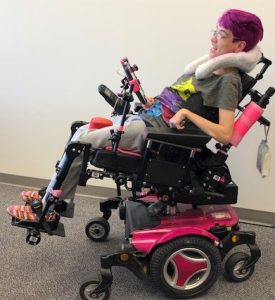Michelle L. Lange, OTR/L, ABDA, ATP/SMS
Dynamic Seating can be used successfully on a power wheelchair, though there are unique parameters which must be considered. Let’s take a look at when Dynamic Seating on a power wheelchair is clinically indicated – and not – as well as these other considerations.
Why is Dynamic Seating not always used on a Power Wheelchair?
Dynamic Seating is used far more often on manual wheelchairs than on power wheelchairs. Why? I believe there are several possibilities:

Kylie with the DRBi and Dynamic Footrests on her Power Wheelchair.
• First, this could be because many people who benefit from Dynamic Seating on a manual wheelchair are not using a power wheelchair.
• Second, the seating and mobility evaluation team may be concerned that movement in a power wheelchair could negatively impact the client’s ability to use the driving method.
• Third, there may be concerns that movement of the footrests could limit accessibility in the environment, as the turning radius increases when the knees are extended. The DRBi does not increase this turning radius.
• Fourth, there may be concerns that the footplates may be more likely to be damaged, or cause damage, if the knees are extended.
Personally, I am a firm believer that many people who are capable of using a power wheelchair are not doing so, for a variety of reasons. We will save that discussion for another time!
Should I use Dynamic Seating on a Power Wheelchair?
The second concern is a valid one. Does movement within the seating system impact the client’s ability to drive? Of course, this is very individual and must be thoroughly evaluated. Dynamic Seating provides small movement which diffuses force. Rather than ‘using tone’ to drive, the client may actually have more functional movement when this movement is not dominated by muscle tone. As the movement is small, the client should remain in alignment with the driving method. Finally, as movement is against the resistance of the dynamic component, the client can still stabilize for driving. I know one clinician who works with a client who can only drive with a Head Array when using Dynamic Footrests to diffuse extension.
The third and fourth concerns both involve the Dynamic Footrests allowing movement into extension. If the client extends, the angle of the footrest will increase which can reduce maneuverability within the environment, cause damage to walls or even lead to damage the footrest itself. I have found that many clients can tolerate a ‘starting position’ that is more flexed as knee extension is allowed beyond this point. For example, if a client can only tolerate a 60 degree static footrest due to extension, that same client may tolerate a 70 degree starting position with a Dynamic Footrest, as this component will then move into greater extension. The Dynamic Footrest allows up to 30 degrees knee extension (limited in part by the amount of resistance used) which may only increase the overall footrest angle to where a static footrest would have been placed. If movement into knee extension does increase the overall footprint of the power wheelchair, the client will have to adjust to this difference during driving, similar to a child transitioning from a smaller pediatric chair to an adult base.


If knee extension is still an issue in driving a power wheelchair, the Dynamic Footrest can be ordered with just the telescoping feature. In this scenario, the footrest moves directly downward up to 1.5” in response to force and does not extend at all, eliminating impact on accessibility. Of course, the seat to floor height must reflect this downward movement so that the footplates cannot move too low, contacting the floor or limiting accessibility from below.
If not secured during power wheelchair driving, the feet may move off of the footplates and be injured. Some clients will only tolerate their feet being secured to the footplate (i.e. with shoeholders) if movement is allowed at the knee by using Dynamic Footrests. With this dynamic component, the client can still move, but safely and with the feet protected.
Our next blog will address which power wheelchair bases are currently compatible with the Seating Dynamics Dynamic Rocker Back Interface (DRBi), Dynamic Footrests, and Dynamic Head Support Hardware.
Are you using Dynamic Seating on power wheelchairs? We’d love to hear from you! Please leave a comment below!
** This post was originally published on https://www.seatingdynamics.com/2018/11/05/can-dynamic-seating-be-used-on-a-power-wheelchair/

